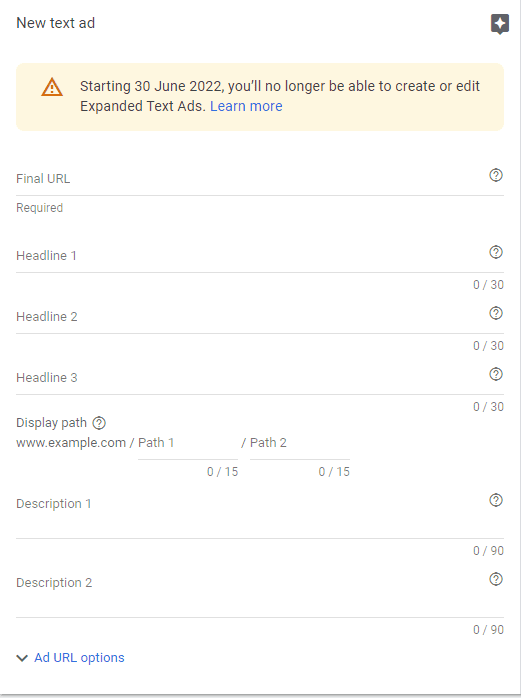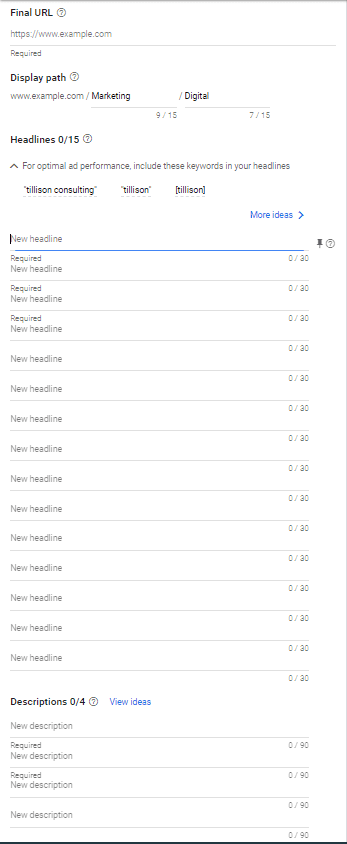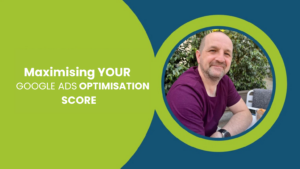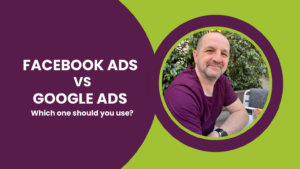At the end of August 2021, Google announced that from June 2022, expanded text ads will no longer be available. From this time, only responsive search ads will be available for creation.
For now, existing expanded text ads will still be available and editable. But, I would only expect this to be the case for a limited time. With these incoming changes, agencies like ours and many others will have to alter their approach and execution of Google search campaigns.
Starting June 30, 2022, responsive search ads will be the only Search ad type that can be created or edited in standard Search campaigns. (Existing expanded text ads will still serve.)
— Google Ads (@GoogleAds) August 31, 2021
Learn more about this update and how to set up your ads for success → https://t.co/tvWACbq42d pic.twitter.com/lTgmfDPAbC
Let’s start at the beginning…
As it currently stands (and until June 2022), Google Ads allows advertisers to create expanded text ads with three headlines, two descriptions and one URL. As well as responsive text ads that contain a collection of fifteen headlines, four descriptions & one URL. Both types of search ads currently have different roles.
Responsive Ads use an automated system to test different ad copy combinations and learn which combinations perform best to achieve campaign goals.
Your campaign goals are selected when you initially create a campaign and could be anything from achieving more sales to more leads and more website traffic. The ad text that Google’s automated system combines must be manually input by advertisers first. Google then generates an advert with three headlines and two descriptions based on the larger ad copy set that has been manually entered.
Meanwhile, what you enter is what you get with an expanded text advert! The text that an advertiser enters into the system is the exact ad copy presented on the search engine. The only change to these is by advertisers manually updating the text.


Statistics
Speaking in cold hard numbers, a responsive text ad can produce a staggering 43,680 combinations to find the perfect blend for your audience. Meanwhile, an expanded ad has, well, one. So on paper, using responsive ads seems like a no brainer, a slam dunk per se. But like many things, it isn’t as straightforward as it seems. But why?
Recent Google Ads Blog Posts
Well, despite having 43,680 potential ad copy combinations at your fingertips (which may seem like a huge asset), at the end of the day, those combinations are all run by an autonomous system. This means you’re relying on technology and not your advertising ability. This loss of control and ability to A/B test in a controlled environment is, in fact, a huge downfall of the new system.
Pinning ad copy
Under the current system, you can control headline and description placements in a responsive text ad by ‘pinning’ them into a specific position. This means that despite the Google responsive ad automation, you can control which text shows and its position no matter the audience.
Brilliant, we’ve cracked the puzzle? Unfortunately, this doesn’t solve the issue. This is because each responsive text ad has a strength rating. Strength is defined as either excellent, good, average or poor. The pinning of a headline or description can, and more often than not, will weaken this strength. One pinned headline can weaken an entire responsive ad from excellent, down to average, or even poor.
Now, I know what you’re thinking. Why does this matter? It matters because ad strength affects how often your ad is served. So, by pinning your headlines and descriptions, you leave yourself in a perilous position where you must choose between preference and control but simultaneously consider risks to performance.
Entering fewer headlines and descriptions
By now, you may be thinking, can’t I enter less text to set up A/B tests? This is another possible yet flawed idea due to…you guessed it, ad strength.
Popular Google Ads Videos
Whilst it is possible to publish a responsive text ad with fewer headlines and descriptions, this will (like pinning) harm your ad strength. Again, limiting how often your ad gets served. Ads ranked poor by Google even come with a warning that they will be limited, and Google strongly recommends strengthening them.
Where that leaves us
But surely, all of the above points defeat the whole concept of a responsive ad? To find the best combinations for the best performance, thus, negating the need for manual A/B testing and streamlining the ad copy process? Well, it’s easy to look at this that way. But even now, the numbers are not foolproof.
There are still many examples where one, or multiple, well created and executed expanded text ads can outperform responsive ones. Even without the statistics in mind, the overall loss of control can be enough to look down on this change. With less advertiser control and more reliance and trust on a system that seems to be moving more and more toward automation.
But, it’s not all doom and gloom, is it?
Absolutely, not. In fact, this change could do lots of good and lead to vastly increased performance if done correctly and given enough of a chance.
This change will no doubt have many positives, including:
Helping you to reach a far wider audience.
Giving you flexibility by catering to a variety of different users.
It would not be far fetched to view one responsive ad as 43,680 different expanded text ads, with each variation potentially perfectly targeted for each specific consumer. Whilst, an expanded text ad may only cater to a very narrow audience.
Of course, if you have very specific targeting, for example, certain demographics and interests then you are likely to reach more relevant audiences and, for an advertiser looking to get multiple facets of their business into the consumer’s eye, creating a series of responsive text ads that can cover multiple bases and can change depending on the audience whilst still conveying the desired message can only be a massive positive.
Google pinpoints the following 5 reasons as positives for the end of expanded text ads
1. Create flexible ads that adapt to device widths, giving you more room to share your message with potential customers.
This is a huge positive. Not being limited by device constraints can drive increased impressions and clicks, especially in today’s market, where mobile, tablet and desktop devices are ever-changing.
2. Save time by providing multiple headlines and description options, then let Google Ads show the most relevant combinations to your customers.
As previously discussed, the streamlining of the A/B testing system alongside Google’s algorithm can save advertisers time and resources. As well as generating a higher amount of impressions and clicks with more relevant ads.
3. You can tailor your headlines and descriptions to your customers’ locations, regular locations or locations of interest.
The ability to personalise ads for specific locations helps to foster a higher click-through rate (CTR). It also allows a single headline to cater for multiple locations and consumers.
4. Reach more potential customers with multiple headlines and description options that allow your ads to compete in more auctions and match more queries.
Following point 2, more headlines to choose from means that your adverts can be more relevant for a higher number of searches. In turn, this results in your account being active in more auctions and the ad being shown more in the search results more frequently.
5. Increase ad group performance by attracting more clicks and conversions that your existing text ads aren’t capturing because responsive search ads help you compete in more auctions.
Moving on from point 4, being shown ‘more’ naturally leads to more chances of receiving clicks. Furthermore, more clicks and traffic to your landing pages give you a better chance of converting potential customers.
As you can see, there are some clear positives toward this change. Responsive ads do seem to be geared toward improving key metrics in a causal sequence, starting with auctions and then impressions, clicks and finally conversions.
Whilst we are talking about responsive ads being the future, it is also important to remember that this is not the definitive end of Expanded text ads. Since the announcement in August 2021, there is still ten months of runway left. Therefore, there is still plenty of time to adapt to this change, look for a solution and become more experienced in optimising responsive text ads. This timeline means that come June 2022, the transition shouldn’t have such a cataclysmic effect on your advertising.
Your Personal Google Ads Video Audit
We'll record a personal audit of your Google Ads account, and explain
- where you're wasting budget
- the opportunities you're missing
- how to improve performance
Get Your Personal Google Ads Audit Now
Get Your Personal Google Ads Audit Video
Please provide your details below and one of our specialists will be in touch as soon as possible.
What’s more, at this point, the changes will only apply to the creation of new expanded text ads. Expanded ads that already exist can still run. Therefore, combined with the ten-month runway given between the announcement and June 2022, this gives advertisers plenty of time to create a thorough library of expanded text ads to run after the change. Or at least time to A/B test in a familiar environment before the transition towards responsive ads only.
The wider picture
It would be the easier option to suggest that Google has simply fallen out of touch with the world’s marketers, but this just isn’t true. The use of automation and algorithms is endemic to society and business, as a whole, showing no sign of stopping anytime soon. So, it was inevitable that this change would, at some point, come into effect.
Year on year, industries across all aspects turn towards automation. The most obvious example is in manufacturing. A study by Statisca showed that even in the COVID-19 years of global automation rose by $28.3 Billion – the largest chunk of this being through process automation.
Looking at the wider picture, the positives to automation are clear. Reduced human error leads to fewer mistakes, risks and wasted company resources. Automation also has a clearer decision-making protocol, focusing wholly on data. On the personnel level, the use of automation frees up time and subsequent company budget. The time previously spent on menial tasks can now be used on upskilling or performing more complex jobs. This can result in a more highly skilled workforce. But, the bottom line is that when used correctly, automation increases efficiency exponentially and saves money.
As proven, the marketing industry is not immune to these changes. But worry not, for the role of agencies is still a crucial role to play despite changing technologies. But why?
Well, when you boil it down, creating any Google search ad isn’t just about entering a collection of words. It’s about understanding market trends, the audience, what they want and what will resonate with them to encourage a click. Whilst machines can understand patterns and analyse data to form relatively accurate conclusions, they cannot account for the small changes in audience and circumstances in the same way a human mind can. Furthermore, the intricacies of human emotion are often still understood better by real people.
Google Ads accounts will still need to be set up, managed and changed in accordance with an ever-changing set of events. For example, take the recent COVID-19 pandemic. Despite all the machine learning and pattern deception in the world, such a sudden change of events would be difficult for any automated entity to effectively navigate.
The end of expanded text ads
The move away from expanded text ads was always inevitable. Much like the move away from text ads in the past. There are, of course, positives to this, and statistically, the transition makes sense. Across the board, responsive text ads perform at a higher level for the same or less cost. But the biggest mistake here is assuming this is a one size fits all scenario.
As proven, there are some circumstances where an expanded text ad would suit better. For instance. where an exact audience and target is required, 15 headlines may become bloated and not get the message across as clearly as an expanded text asset.
However, as alluded to above, there is still plenty of time before this transition is implemented, giving advertisers time to prepare effectively for this change. Despite the move toward a more automated and algorithmic approach, understanding what makes a search ad successful will remain vital and at the forefront of whatever this change may bring to the industry.
We’re a PPC agency – specialising in Google Ads and Google Shopping so remember to get in contact today to see how we can deliver excellent results for you!











2 Responses
This is actually an astonishing article. Much appreciated for sharing a piece of great data keep it up and most amazing aspect karma with your future article and post.
Your blog is excellent and contains a wealth of information about digital marketing. We appreciate you sharing this interesting and well-written information with us. It was quite fascinating.